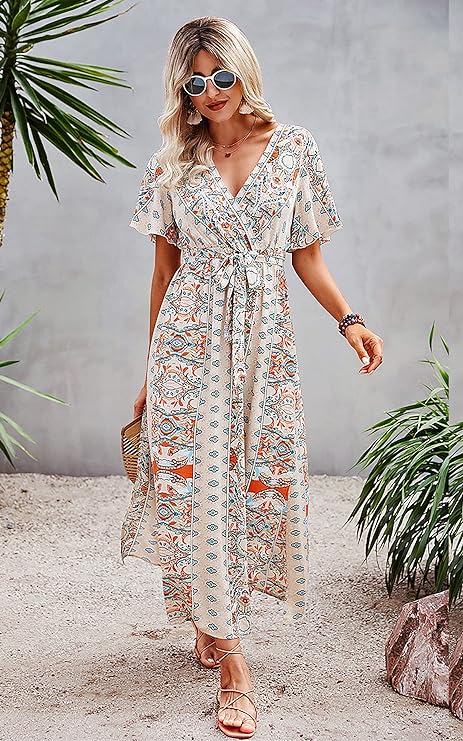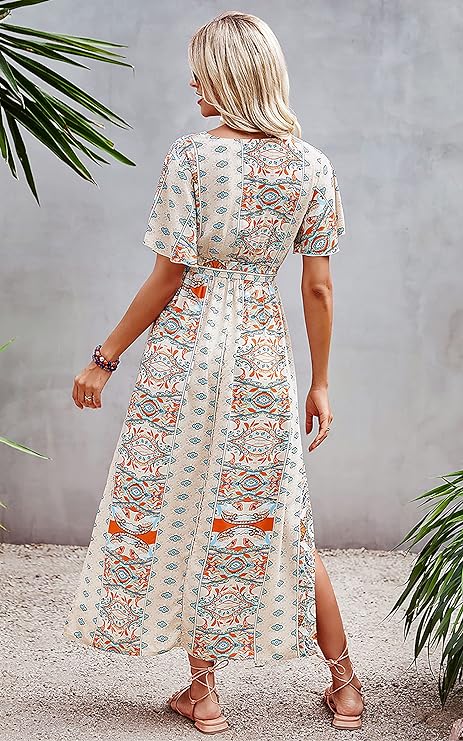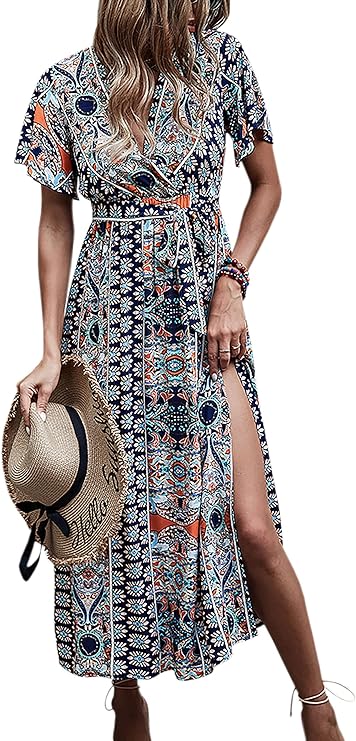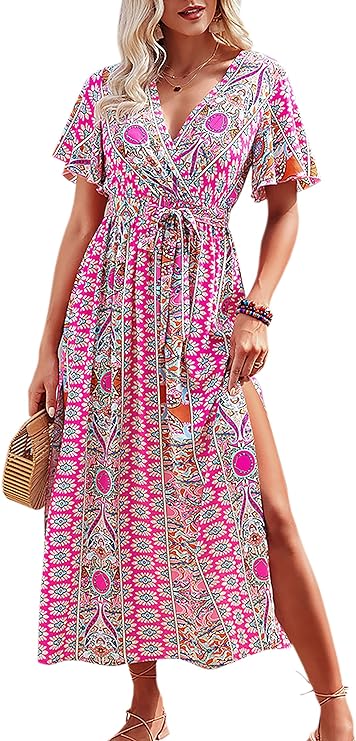Batting between the rich tapestry of Japanese tradition and the rapidly changing tides of global fashion, the robe kimono stands as a testament to timeless beauty and resilience. Transcending its origins as a traditional Japanese garment, the kimono dress has evolved while maintaining its symbolic essence, continuously reinventing itself to fit the modern wardrobe. This article delves into the history of the kimono dress, its cultural significance. And the ways in which it has been adapted to align with contemporary fashion trends without forsaking its ancestral roots.
The Origins of the Kimono Dress
Historical Significance
The traditional kimono, with a history that can be traced back to the Heian period (794-1185), was once the standard attire for Japanese people, embodying a complex cultural heritage. Its name, which literally means “thing to wear,” only hints at the intricate artistry of its design, construction, and symbolism. Originally made from silk and adorned with elaborate patterns that symbolize various aspects of Japanese philosophy and aesthetics. Such as nature and seasons, the kimono has always been more than just a garment. It has been a canvas for expression and a ceremonial emblem.

Role in Cultural Identity
Kimono dresses boast an unmistakable style, often characterized by a T-shaped, wraparound design with a collared neckline and wide, flowing sleeves. They are tied with a sash called an obi. Which can be styled in numerous ways and often acts as a focal point of the ensemble. The construction and ritual dressing of the kimono reflect a meticulous attention to detail and a philosophy that values presentation and poise. It is a garment deeply intertwined with Japanese identity, representing formality, sophistication, and respect for tradition.
Craftsmanship and Techniques
Making a traditional kimono is a labor-intensive process that involves a range of specialized skills, from the weaving and dyeing of the fabric to the hand-painting or embroidery of intricate patterns. Each kimono is a work of art, reflecting the craftsmanship and dedication of its makers. The techniques passed down through generations have been safeguarded, ensuring that the art of the kimono remains alive. These traditional methods garner deep respect within the fashion community, underscoring the kimono’s status as both a cultural artifact and a wearable piece of history.

The Kimono Dress in Modern Fashion
Adaptations for Contemporary Style
In the modern fashion dress landscape, the kimono dress has been adapted into various forms, often maintaining the essence of the traditional design while catering to contemporary tastes and lifestyles. Designers have experimented with different lengths, fabrics, and patterns to create a versatile array of kimono-inspired attire suitable for casual, business, and formal occasions. The adaptability of the kimono dress has allowed it to persist as a fashionable choice. Embodying a unique blend of elegance and comfort that appeals to a diverse audience.
Global Influence and Trends
The international appeal of the kimono dress is a testament to its aesthetic versatility and the global fashion industry’s appetite for cross-cultural influences. From high-end fashion runways to mainstream retail, kimono-inspired designs have permeated various markets, often serving as a bridge between East and West. This has introduced new demographics to the allure of the kimono dress, elevating its status from ethnic attire to an integral component of global fashion trends.

Challenges of Cultural Appropriation
As the kimono dress gains popularity in the global fashion scene, it also faces challenges related to cultural appropriation. The manner in which kimono-inspired fashion is adopted, adapted, and marketed by non-Japanese designers can sometimes blur the lines between cultural appreciation and appropriation. It is crucial for the fashion industry to approach the kimono dress with sensitivity and respect. Recognizing the cultural heritage and significance behind the garment. Responsible representation and education can help ensure that the legacy of the kimono dress is honored in the world of modern fashion.
The Kimono Dress in the Future
Innovations and Eco-Friendly Practices
Innovation in fashion often means embracing sustainability, and the kimono dress is no exception. There’s a growing movement toward using eco-friendly materials and ethical production techniques to create kimono dresses that not only look beautiful but also align with environmental values. Designers are exploring the use of organic fabrics, natural dyes, and zero-waste manufacturing processes to update the kimono dress for a new generation of conscious consumers. These sustainable practices ensure the garment’s enduring legacy, serving both the planet and the continued intrigue surrounding the kimono.
The Digital Space and Customization
Moreover, The digital age has paved the way for new expressions of the kimono dress, from online retail spaces offering custom-made designs to virtual fitting rooms where one can try on different styles. The use of digital tools and platforms allows designers to reach a wider audience and provides consumers with unprecedented access to personalized kimono dresses. This intersection of tradition and technology is forging a fresh path for the kimono dress. Emphasizing individuality and accessibility in a garment steeped in heritage.

Fusion with Technology and Smart Fabrics
Looking forward, the integration of technology within textiles opens further avenues for reinventing the kimono dress. The incorporation of smart fabrics that can change colors, regulate temperature. Or connect to the Internet offers intriguing possibilities for the future of this classic garment. Designers and tech innovators have the potential to craft kimono dresses that not only carry the cultural weight of their past but also serve modern functionalities, melding tradition with cutting-edge innovation in wearable technology.
Cultural Preservation and Education
The Importance of Cultural Preservation
Moreover, As the kimono dress evolves, it is imperative to preserve the cultural significance and traditional techniques that underlie its beauty. Efforts to safeguard the artistry of kimono-making, from weaving to dyeing to stitching. Are critical in ensuring that these skills are not lost to time. Museums, cultural institutions, and fashion schools play a vital role in this endeavor, offering exhibits, workshops. And courses that highlight the history and craft of the kimono. By engaging with the kimono dress on a cultural level. We can celebrate this garment’s past and contribute to its living legacy.
Educational Opportunities and Global Exchange
Therefore, Educational programs centered around the kimono dress can serve as a gateway for people worldwide to engage with Japanese culture and its fashion heritage. Exchange programs, collaborations between international designers, and cross-cultural fashion shows can foster a deeper appreciation and understanding of the kimono. Education is the key to navigating the complexities of cultural representation in fashion. Ensuring that the homage pay to the kimono dress is done with authenticity and respects

Conclusion: The Evolving Legacy of the Kimono Dress
A Symbol of Cross-Cultural Dialogue
The kimono dress has come to symbolize more than a piece of traditional attire; it now stands as a beacon of cross-cultural dialogue in the global fashion narrative. As it is embrace by different cultures and interpret in new ways. The kimono dress illustrates the power of fashion to transcend geographical and cultural boundaries. This journey from a national emblem to an international fashion inspiration is a testament to the enduring appeal and adaptability of the kimono dress.
Balancing Tradition and Innovation
Finally, The future of the kimono dress lies in the delicate balance between honoring tradition and embracing innovation. As fashion continues to evolve, the challenge will be to maintain the integrity and essence of the kimono while allowing room for creative expression and modernization. Through thoughtful design, responsible practices, and cultural awareness. The fashion industry can ensure that the kimono dress remains both a cherished artifact of Japanese culture and a vibrant. Evolving element of contemporary style.
